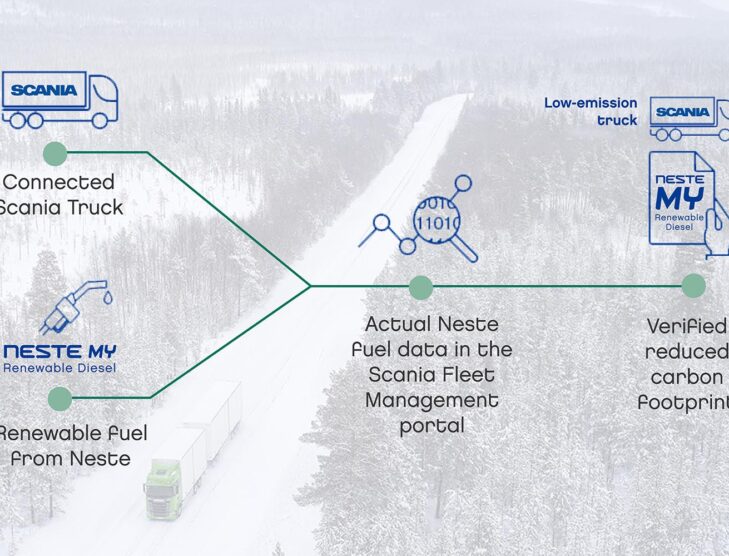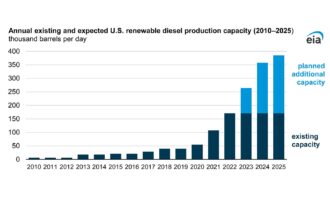
Neste and Scania track renewable fuels use with digital solution
Until now, it has been a challenge to verify to what extent trucks really run on renewable fuels, as the very same trucks could also continue to run on fossil fuels. The digital solution now being tested by Neste and Scania hopes to solve this concern.
Neste and Scania are piloting a digital solution that enables easy follow-up and verification of each truck’s usage of renewable fuels. Combining data from Scania Fleet Management Portal enriched with Neste’s fuel emission data, the solution provides Scania’s fleet management customers with accurate, up-to-date data for their greenhouse gas emissions (GHG) reporting and sustainability communications. Customers can compare the climate impact of their use of Neste’s renewable fuels to fossil fuels and track their continuous progress towards climate targets.
Neste’s and Scania’s joint ambition is that the solution could in the future serve all fleet manufacturers and all types of renewable fuels.
Neste and Scania are testing the digital solution with the logistic companies HAVI and UFF. The solution combines data regarding where a certain truck has been refuelled and how much it has driven, with data about the climate impact as a result of the use of Neste MY Renewable Diesel™ instead of fossil fuel.
“The purpose of our unique collaboration is to test together with a fleet manufacturer how to verify the use of renewable fuels and accurately report the climate impact. The climate data flows now digitally through the systems, whereas before, it was mostly collected manually from different sources. Our pilot with Scania started by finding out the challenges that transport companies currently face in developing the sustainability of their fleet and related sustainability reporting. We invited customers in the transportation business to take part in interviews to provide the service design team at Scania a deeper understanding on their sustainability development challenges. We also wanted to support Scania’s own efforts to follow-up and report their own progress on the Science Based Targets initiative. Encouraged by the successful pilot in Finland, we are now looking into expanding the solution to the new markets,” said Mats Hultman, head of OEM Partnerships at Neste.
“Scania’s purpose is to drive the shift towards a sustainable transport system, creating a world of mobility that is better for the business, society and the environment. We are sure that data transparency, connectivity and partnerships in the ecosystem are vital to accelerate this journey, where energy efficiency, electrification, renewable fuels and smart and safe transport are all part of the solution. In this collaboration our aim was to enable access to reliable, accurate and automated emissions calculations that could be used both in daily operations but also showcase the credibility of renewable fuels in the ecosystem,” said Jacob Thärnå, head of Sustainable Transport at Scania.
“HAVI is committed to net zero emissions by 2050 and we’re proud to work with our customers and partners to provide increasingly sustainable, digitally enabled and transparent supply chain solutions. With much of our European delivery fleet now powered by alternative fuels such as electrification, biogas and renewable diesel, we’re delighted that this pioneering digitalisation initiative from Scania and Neste enables automatic reporting into the real GHG reductions achieved on behalf of our customers. More widely, deliveries with a verifiably lower carbon footprint could also strengthen trust in the progress that is being made toward net zero,” said Massimo D’Alessandro, director of Sustainability & Innovation, HAVI.
“Together with Scania and our piloting customers, HAVI and UFF, we aim to demonstrate how climate data can create additional value and push the logistics industry towards lower emissions. Collaboration in the whole industry value chain is important when new solutions are developed, and this pilot is a good example of a customer-centric solution that paves the way for the whole industry to combat climate change,” Hultman said.









